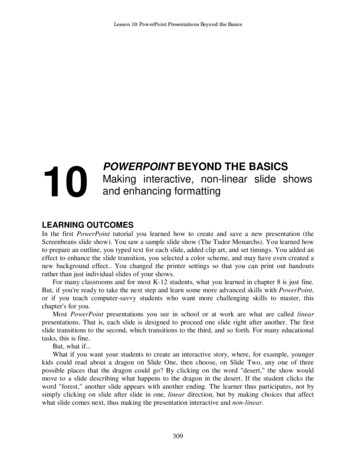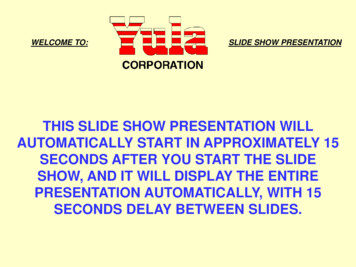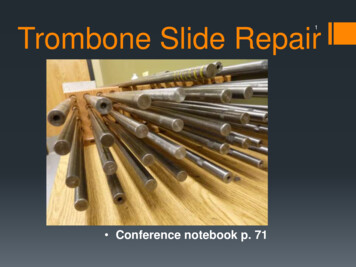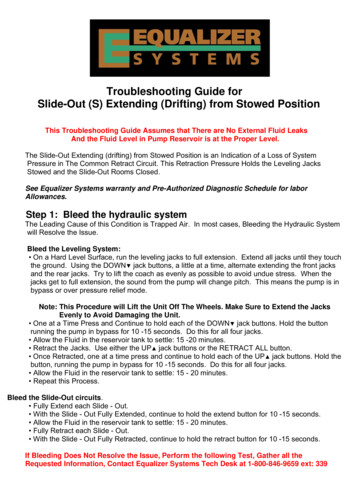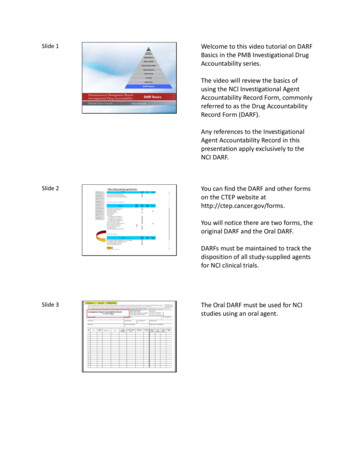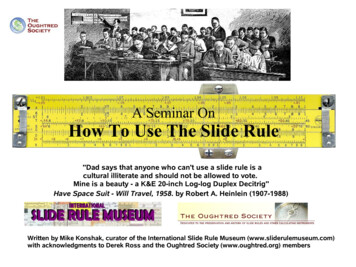
Transcription
A Seminar OnHow To Use The Slide Rule"Dad says that anyone who can't use a slide rule is acultural illiterate and should not be allowed to vote.Mine is a beauty - a K&E 20-inch Log-log Duplex Decitrig"Have Space Suit - Will Travel, 1958. by Robert A. Heinlein (1907-1988)Written by Mike Konshak, curator of the International Slide Rule Museum (www.sliderulemuseum.com)with acknowledgments to Derek Ross and the Oughtred Society (www.oughtred.org) members
Apollo 11 - NASA's Lunar Landerspace vehicle, with the crew NeilArmstrong, Buzz Aldrin andMichael Collins carried slide rules,for the first time in history, intospace and onto the moon, July,1969. The slide rule of choice wasthe aluminum pocketPickett 600-T Dual base Log Log.“We went to the moon with sliderules,” retiree Norman Chaffee, whoworked on the spacecraft propulsionsystem, “I didn’t even have my firstfull-function calculator until 1972."Note: When you watch the movieApollo 13 look for the engineersusing slide rules
Prior to 1980, Webster'sDictionary defined the word“COMPUTER” as a PERSONwho computes, typicallywith a slide rule.The HP-35 “Slide Rule Calculator”was first introduced inthe mid-1970's,and sold for 295*.This calculator started thedemise of the slide rule industry.* 3000 in today's money
Brief History of the Slide RuleJohn NapierWilliam OughtredAmédée Mannheim1614 - Invention of logarithms by John Napier, Baron of Merchiston, Scotland.1617 - Developments of logarithms 'to base 10' by Henry Briggs, Professor of Mathematics, Oxford University.1620 - Interpretation of logarithmic scale form by Edmund Gunter, Professor of Astronomy, London.1630 - Invention of the slide rule by the Reverend William Oughtred, London.1657 - Development of the moving slide/fixed stock principle by Seth Partridge, Surveyor/Mathematician, England.1775 - Development of the slide rule cursor by John Robertson of the Royal Academy.1815 - Invention of the log log scale principle by P.M. Roget of France.1850 - Amédée Mannheim, France, produced the modern arrangement of scales.1886 - Dennert & Pape, Germany, introduce white celluloid as a material for inscription of scales.1890 - William Cox of the United States patented the duplex slide rule.c1900 - Engine divided scales on celluloid increases precision of slide rules.1976 - The final slide rule made by K&E donated to the Smithsonian Institute, Washington, DC, USA.Today, slide rules can be found on eBay, antique stores and estate auctions. Lost inventories of brand new sliderules turn up every year.
Table of Contents (TOC) ··A Brief History the Slide Rule··The Parts of a Slide Rule··Reading the Scales··Multiplication··Simple Multiplication (uses C and D scales)··'Wrap-Around' Multiplication (uses C and D scales)··Folded-Scale Multiplication (uses C, D, CF and DF scales)··Multiplication by π (uses D and DF scales)··Division··Simple Division (uses C and D scales)··Reciprocal (uses C and CI scales)··Trigonometry··Sin(x) for angles between 5.7 and 90 (uses S and C scales)··Cos(x) for angles between 5.7 and 90 (uses S and C scales)··Tan(x) for angles between between 5.7 and 45 (uses T and C scales)··Tan(x) for angles between between 45 and 84 (uses backward T and CI scale)··Tan(x) for angles between between 45 and 84 (uses forward T and C scale)··Sin(x) and tan(x) for angles between 0.6 and 5.7 (using the ST and C scales)··Sin(x) and tan(x) for other small angles (using C and D scales)··Squares and Square Roots··Square (uses C and B scales)··Square Root (uses C and B scales)··Cubes and Cube Roots··Cube (uses D and K scales)··Cube Root (uses D and K scales)··Log-Log Scales··Raising a Number to Powers of 10 (N 1)··Raising a Number to Powers of 10 (N 1)··Raising a Number to Powers of -10 (N 1) or 1/X10··Finding the 10th Root (N 1 ··Finding the 10th Root (N 1)··Arbitrary Powers (Staying on Same LL Scale)··Arbitrary Powers (Switching LL Scales)··Log-Log Approximations··Slide Rule Loaner Program··Additional Training Resources
Parts of a Slide Rule
Reading the ScalesThe scales on a slide rule are logarithmic, in that the spacing betweendivisions (the lines on the scale) become closer together as the valueincreases. This is why the slide rule is able to do multiplication and divisionrather than addition and subtraction. Compare the two sets of offset scalesbelow in Figure B. In both cases the left index X:1 or C:1 is placed over thefirst whole number, either Y:2 or D:2. On a linear scale the value of anynumber on the X scale as read on Y is increased by 1. On a logarithmicscale, the value on any number on the C scale as read on the D scalebecomes a multiple of the number under the index.William Oughtred discovered the above characteristic in 1630, when heplaced two logarithmic scales that were invented by his contemporary,Edmund Gunter, alongside each other. Thus the slide rule was born.
Reading the Scales, Cont'd.At this point it is best to just describe how to read the scales. On almost all sliderules, the black scales (A, B, C, D, K, etc.) increase from left to right. The redscales, or inverse scales (CI, DI), increase from right to left. The pocket sizedPickett 600-ES will be used in most illustrations. The full sized Pickett N3-T forothers. By the way, the Pickett 600-T (white) was taken by theApollo 11 NASA astronauts to moon.
Reading the Scales, Cont'd.Except for 'folded', 'trig' or Log' scales, each scale begins with 1. C and D scales aresingle logarithmic (1-10) scales. The A and B scales are double logarithmic (1-10-100)having two cycles of 1-10, the K scale being triple logarithmic (1-10-100-1000) havingthree cycles of 1-10. The Primary divisions are whole numbers. The secondary divisionsdivide the Primary by 10, the Tertiary divisions divide the secondary by 5. Of course asyou get to the end of each scale the divisions get so close together that the tertiarydivisions disappear. The scales on each side of a slide rule are aligned so that calculationscan be carried from one side to the other.
Approximating ValuesIts important to become familiar with not only the physical divisionsas marked on the scales, but in becoming able to approximate valueswhen the hairline falls in the spacing between divisions. Positions ofthe slide and cursor shown in the examples will mention the label ofthe scale and the value on the scale, such as scale C at 1.5 will bereferenced as C:1.5.On the left end of the scales, where the divisions are further apart, itis easy to judge the next decimal place value between in 1/10thincrements (.1, .2, .3 etc) but on the other end, a hairline fallingbetween two divisions might only be estimated as close as a half (.5).
Scientific Notation and Significant DigitsThe maximum resolution of a slide rule is only 2-4 digits depending on which end ofthe scale is being read.Additionally, The slide rule does not tell you where the decimal point is located inthe answer. To do a calculation with a slide rule you reduce all numbers to scientificnotation with 2-4 digits then use the slide rule to perform the basic operations. In aseparate calculation you find the order of magnitude by combining the powers of 10.It is up to the operator to determine if the result makes sense or not.Suppose you were given that the earth'sdiameter at the equator is 7,926.41 miles and. you are asked to find the circumference usingC π DThe value for π, for example is 3.14159. butfor slide rule calculations we round that to 3.1or 3.14.We would round D 7926.41 to 7.93 x 1000or 7.93 x 103
Scientific Notation and Significant Digits, cont'dNow its a simple task of using the slide rule to multiply 3.14 x 7.92 x 1000 Thefinal result on the slide rule would have read 2.49, but we can easily mentallycalculate that 3 x 8 24, so what you are seeing should be 24.9. We then add the 3decimal places (the zero's in 1000) to shift the decimal point to 24,900 miles.In talking with someone you might further round off your answer to say that theearth's circumference at the equator is about 25,000 miles, and for all practicalpurposes you'd be correct. Your calculator gave you an answer of 24,868.8, butyou'd be a real boor if you rattled off that number to your friends. The differencebetween 24,900, 25,000 or 24,868.8 is less than a one-half of one percent, so theerror is very small. Remember we made it to the moon and engineered everystructure you see before 1970 using slide rule accuracy.The curse and blessing of modern calculators is that this type of thinking is nolonger necessary or encouraged by educators. Students just hit buttons and copydown what is on the display. Of course the fact that most of the digits in thedisplay of a calculator is useless noise does not bother most students. Modernstudents are not challenged to judge whether or not the calculator's result is in theright range, and errors can be propagated
1. Simple Multiplication (uses C and D scales)Example: calculate 2.3 3.4 Slide the leftmost Index '1' on C over 2.3 on the D scale. Move the cursor to 3.4 on the C scale. The cursor is on the D scale just a bit over 7.8 or 7.82. This is the answer.
2. 'Wrap-Around' Multiplication (uses C and D scales)Example 2a: calculate 2.3 4.5 Move the left Index on C to 2.3 on the D scale. Try to move the cursor to 4.5 on the C scale. The cursor is blocked by thebrace (also called strap or bridge). The target C:4.5 is off the D scale. The right Index must now be used.
Example 2b: calculate 2.3 4.5 Move the right Index on C (C:1) to over 2.3 on the D scale (D:2.3) Slide the cursor to 4.5 on the C scale (C:4.5) On the D scale, you'll see that the hairline is between divisions. Estimate theanswer to 1.035. Do a rough approximation by rounding 2.3 to 2 and 4.5 to 5. We mentally calculate 2 5 10, so we adjust the decimal place to get 10.35 or10.4.
3. Folded-Scale Multiplication (uses C, D, CF and DF scales) Example 3: calculate 2.3 4.5Slide the leftmost Index, '1', on C over the 2.3 on the D scale (D:2.3).We can't move the cursor to 4.5 on the C scale; it's out of range. We can use thefolded scales to get this answer.Move the cursor to 4.5 on the CF scale (CF:4.5).The cursor is now at 1.04 on the DF scale (DF:1.04).We know the correct answer is near 2 5 10, so we adjust the decimal placeto get 10.4.
4. Multiplication by π (uses D and DF scales)Example 4: calculate 123 π Move the cursor to 1.23 on the D scale. The cursor is now at 3.86 on the DF scale. We know that the correct answer is near 100 3 300,so we adjust the decimal place to get 386.
5. Simple Division (uses C and D scales) Example 5: calculate 4.5 / 7.8Move the cursor to 4.5 on the D scale.Slide 7.8 on the C scale to the cursor.Move the cursor to either the leftmost or rightmost '1' on the C scale,whichever is in range. In this case, you would move it to the rightmost '1'.The cursor is now at 5.76 on the D scale.We know that the correct answer is near 4/8 0.5, so we adjust thedecimal place to get 0.576.
6. Reciprocal (uses C and CI scales)Example 6: calculate the reciprocal of 7.8, or 1/7.8 Move the cursor to 7.8 on the CI scale. Note that the CI scaleincreases from right to left, as indicated by the ' ' symbols beforethe numbers. The cursor is now at 1.28 on the C scale. We know that the correct answer is near 1/10 0.1, so weadjust the decimal place to get 0.128.
Trigonometry7. Sin(x) for angles between 5.7 and 90 (uses S and C scales)Example 7: calculate sin(33 ) Move the cursor to 33 on the S scale. The cursor is at 5.45 on the C scale. We know that the correct answer for a sin in this range is between0.1 and 1, so we adjust the decimal place to get 0.545.
8. Cos(x) for angles between 5.7 and 90 (uses S and C scales) Example 8: calculate cos(33 ).The cos scale shares the sin S scale. Instead of increasing fromleft to right like the sin scale, cos increases from right to left. This isindicated on the slide rule by ' ' characters which remind you thatthe number in increasing 'backwards'.Move the cursor to 33 on the S scale.The cursor is now at 8.4 on the C scale.We know that the correct answer for a cos in this range isbetween 0.1 and 1, so we adjust the decimal place to get 0.84.
9. Tan(x) for angles between between 5.7 and 45 (uses T and C scales)Example 9: calculate tan(33 ) . Move the cursor to 33 on the T scale. The cursor is now at 6.5 on the C scale. We know that the correct answer for a tan in this range is between 0.1and 1, so we adjust the decimal place to get 0.65.
10. Tan(x) for angles between between 45 and 84 (uses backward T and CI scale)Example 10a: calculate tan(63 ) (Figures 10a and 10b) Move the cursor to 63 on the T scale. Note that this range increases from rightto left, as indicated by the ' ' before the numbers. The cursor is now at 1.96 on the DI scale. Figure 10aGo to the next slide Please
Example 10a: calculate tan(63 ) Move the cursor to 63 on the T scale. Note that this range increases fromright to left, as indicated by the ' ' before the numbers. The cursor is now at 1.96 on the DI scale. Figure 10a Flip to the other side of the slide rule. The cursor is also at 1.96 on the CIscale. Figure 10b We know that the correct answer for a tan in this range is between 1 and 10, sowe don't need to adjust the decimal place.
11. Tan(x) for angles between between 45 and 84 (uses forward T and Cscale)Example 11: calculate tan(63 ). Move the cursor to 63 on the forward T scale. This scale increases fromleft to right. The cursor is now at 1.96 on the C scale. We know that the correct answer for a tan in this range is between 1and 10, so we don't need to adjust the decimal place.
12. Sin(x) and tan(x) for angles between 0.6 and 5.7 (using the ST and C scales)In this range, the sin and tan functions are very close in value, so a single scale canbe used to calculate both.Example: calculate
The scales on a slide rule are logarithmic, in that the spacing between divisions (the lines on the scale) become closer together as the value increases. This is why the slide rule is able to do multiplication and division rather than addition and subtraction. Compare the two sets of offset scales below in Figure B. In both cases the left index X:1 or C:1 is placed over the


